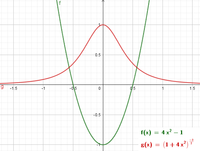Hi everyone, please I need help with this problem. I am stuck. See below
Can someone please help with this problem: Approximate the points at which the graphs of f(x) = 4x^2 − 1 and g(x) = (1 + 4x^2)^(−3/2) intersect, and approximate the area (in units^2) between their graphs accurate to three decimal places.
I used a graphing calculator to plot the graph and found the point of intersections to be approx x=0.6 and -0.6. Then I found the antiderivative of f(x) as (4x^3)/3 -x. the antiderivative of g(x) I found to be [-(1+4x^2)^(-1/2)]/4x. I did not include +C because it's definite integral from -0.6 to 0.6. I subtracted the lower function f(x) from the upper function g(x) i.e. g(x) - f(x) and got 0.065 but that was wrong. What else should I do? I need someone to help, please.
Thanks.
Can someone please help with this problem: Approximate the points at which the graphs of f(x) = 4x^2 − 1 and g(x) = (1 + 4x^2)^(−3/2) intersect, and approximate the area (in units^2) between their graphs accurate to three decimal places.
I used a graphing calculator to plot the graph and found the point of intersections to be approx x=0.6 and -0.6. Then I found the antiderivative of f(x) as (4x^3)/3 -x. the antiderivative of g(x) I found to be [-(1+4x^2)^(-1/2)]/4x. I did not include +C because it's definite integral from -0.6 to 0.6. I subtracted the lower function f(x) from the upper function g(x) i.e. g(x) - f(x) and got 0.065 but that was wrong. What else should I do? I need someone to help, please.
Thanks.
Last edited:

